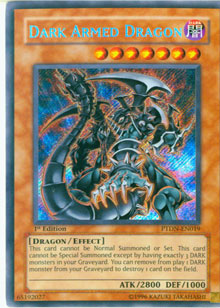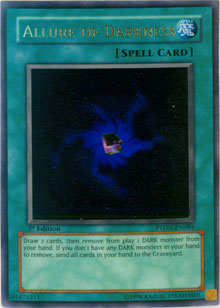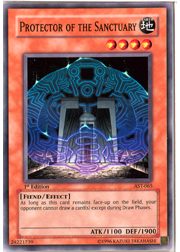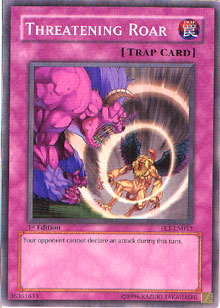It’s no secret that the relatively new Dark Armed Dragon decks have been dominating the format. In the end though, the format isn’t dominated by cards alone, but by the cards the players are taking to the major tournaments. Innovation is the key to unlocking a balanced format, and it’s something every player  is capable of. The first step to defeating the Dragon (yes, that does sound like a Bruce Lee movie) is analyzing it. To defeat it, one must first find what the deck depends on.
is capable of. The first step to defeating the Dragon (yes, that does sound like a Bruce Lee movie) is analyzing it. To defeat it, one must first find what the deck depends on.
One must first recognize that there are two ways to defeat Dark Armed Return. The first is by moving even faster and more consistently than the Dragon, which decks such as the Dark Magician of Chaos/Dimension Fusion OTK decks do. This is a good strategy, but completely irrelevant to the Dark Armed Dragon deck itself. Instead, we’ll be considering the second way of defeating the deck: strategic anti-measures taken to slow the game down, stopping what many players are calling OTK syndrome. If the deck created and used to defeat Dark Armed Dragon is just a faster one-turn KO deck, then all we’ve done is replace it: nothing changes. However, if we are actually able to consistently slow the game down to a conservative speed and deliver the game from the strategy of constant rushing, we‘ve completely destroyed the entire mindset the players running the Dragon are abusing. This is what the following theories will consider in terms of defeating the Dragon.
Establishing the Enemy
Despite the common misconception, the actual Dark Armed Dragon card is not the means through which the deck has been dominating. The Dragon is simply a piece of utility that the deck relies on: a means to the powerful one-turn KO that the deck is consistently capable of. This is an important fact to remember: while many players will quickly rush to stop their opponents from manipulating the graveyard with remove-from-play decks, there is a reason why such builds have not held up to expectations. With this in mind, we’ll consider Jerry Wang’s decklist. He made the claim that his build was the best, and then he proved it. Self-fulfilling prophesy or not, the Yu-Gi-Oh! TCG community is going to take notice. For this article, this will be treated as the "stock" build for the deck.
The publishing of decklists such as this has many effects on the game, two of which are important to note at this moment: everyone else knows this decklist and may want to use it (or, worse for us, improve upon it), but it also means we have the information necessary to stop it. The other pieces of information we have on hand are the feature matches, which allow entry into the actual workings of the deck. Notice how the deck operates during a game, and why it moves so quickly. In the final match of Shonen Jump Championship Columbus, in which Wang’s Dark Armed Dragon deck was victorious, the two players had an exchange that is extremely relevant to the deck, the format in general, and where its real power lies:
Diaz: "I can’t believe you got Crush on your first turn."
Wang: "Well, I did go through about twenty cards."
I challenge you to test the Dark Armed Dragon deck without the power to draw any additional cards. Take away the three copies of Destiny Draw, Allure of Darkness, and Cyber Valley, and see how strong the opening hands will be. To continue with the analysis of the strategy, you should have a Dark Armed Dragon deck. If you can’t afford the cards, simply "proxy" them by writing the names of the cards you don’t have on pieces of paper, which you can place on top of your real cards and into a sleeve. This way, you’ll be able to represent the hands drawn in a real dueling situation, and simple theory becomes a thing of the past. Once you do this, play ten games with the deck you’ve built, but don’t activate anything that allows you to draw more cards. Your hands will almost always be locked and useless.
Step 1 in Defeating the Dragon: Stop the Deck’s Drawing Power Directly
Once you stop the deck from drawing more cards, you also inadvertently stop its ability to  control the graveyard and removed-from-play piles. To emphasize the power of this, let’s take a look at the decklist once the additional drawing power is halted.
control the graveyard and removed-from-play piles. To emphasize the power of this, let’s take a look at the decklist once the additional drawing power is halted.
The change here may not be self-evident. There are actually very few cards that are directly affected by the negation of draw power. However, notice how many cards are indirectly affected. If a player can’t draw additional cards, Destiny Hero - Malicious is nearly impossible to use, especially if drawn in the opening hand. Monster Reborn and Premature Burial will be difficult to use as well. Dark Armed Dragon itself will be difficult to summon without the ability to cycle through cards quickly. Also, because Mind Crush and Trap Dustshoot are rarely useful beyond turn 1, your opponent will actually have to draw them in his or her opening hand without the use of extra draw power, which is very rare. Finally, the summoning of the other tribute monsters or the use of them in any way becomes extraordinarily difficult. In truth, here’s a list of the cards our opponent will most likely be able to use on the first turn if he/she can’t draw additional cards.
For a deck that likes to win on the first or second turn, this isn’t a great deal of usable cards remaining. The power behind the Dark Armed Dragon deck isn’t really in its one-turn KO capabilities—there are many OTK decks other than the Dragon, and there almost always  have been. The deck’s true power lies in its ability to rip through itself in the matter of a single turn. If this can be stopped, the deck can be stopped. The first powerful card we’ve discovered (and possibly the most improved card this format) is Protector of the Sanctuary. It’s small, and requires a lot of attention to keep on the field, but its effect is absolutely devastating to Dark Armed Return.
have been. The deck’s true power lies in its ability to rip through itself in the matter of a single turn. If this can be stopped, the deck can be stopped. The first powerful card we’ve discovered (and possibly the most improved card this format) is Protector of the Sanctuary. It’s small, and requires a lot of attention to keep on the field, but its effect is absolutely devastating to Dark Armed Return.
However, we’ll only have Protector of the Sanctuary in an opening hand about 37 percent of the time if we run the three copies allowed, which isn’t consistent enough to stop the Dragon. We’ll need to be able to combat the deck on turn 1 at least 80 percent of the time for the strategy to be successful over a long range of tournament play (if you have a total of 80 percent consistency on stopping the drawing engine in a single game, your chances of doing it at least once in a match are 99 percent, accounting for half the wins you‘ll need to take the match). If major tournaments were smaller, then variance might be enough justification for not pushing harder against the deck. However, if you plan on pushing for the long haul, you’re going to need more.
Step 2 in Defeating the Dragon: Stop the Deck’s Drawing Power Indirectly
There is another way of stopping the card-drawing power of the deck. Every form of card drawing the deck has is monster-based in some way: Destiny Draw, Allure of Darkness, and  all require monsters in an opening hand to be used. There’s a long-forgotten card that has to be used in conjunction with Necrovalley, and its name is Royal Tribute. Normally, I wouldn’t suggest using a card that requires another one in order for it to be activated, especially when it’s best used on the first turn. However, Necrovalley has uses of its own against the Dragon. With Necrovalley on the field, Dark Armed Dragon can’t use its effect to manipulate the graveyard and create a strong removed-from-play pile. Destiny Hero - Malicious and Destiny Hero - Disk Commander are useless, and Dark Magician of Chaos cannot return a spell to his controller’s hand (which is incredibly useful when you’re against the Dark Magician of Chaos OTK deck). Monster Reborn and Premature Burial can’t be used, and Cyber Valley can’t put a spell back on top of the deck. All of this makes Royal Tribute a very viable option. We have a blending of synergy and utility against the Dragon, which is an extraordinary plus.
all require monsters in an opening hand to be used. There’s a long-forgotten card that has to be used in conjunction with Necrovalley, and its name is Royal Tribute. Normally, I wouldn’t suggest using a card that requires another one in order for it to be activated, especially when it’s best used on the first turn. However, Necrovalley has uses of its own against the Dragon. With Necrovalley on the field, Dark Armed Dragon can’t use its effect to manipulate the graveyard and create a strong removed-from-play pile. Destiny Hero - Malicious and Destiny Hero - Disk Commander are useless, and Dark Magician of Chaos cannot return a spell to his controller’s hand (which is incredibly useful when you’re against the Dark Magician of Chaos OTK deck). Monster Reborn and Premature Burial can’t be used, and Cyber Valley can’t put a spell back on top of the deck. All of this makes Royal Tribute a very viable option. We have a blending of synergy and utility against the Dragon, which is an extraordinary plus.
In Wang’s final match, there was a point at which he seemed to be doomed. He was holding two copies of Destiny Draw, but no monsters. Had he not drawn Destiny Hero - Malicious the following turn, he almost certainly would have lost. Notice how unplayable a no-monster opening hand is for the deck.
Find any six cards that don’t include the single Reinforcement of the Army and create a playable starting hand. If your opponent is willing to gamble with Allure of Darkness, you’re going to have to allow it. Just remember that the benefit of such a gamble could mean the outcome of the game in your favor. Now, assuming you run three copies of Gravekeeper’s Commandant, you’ll only have about a 23 percent chance of playing Royal Tribute on your first turn. However, this means there’s about a 56 percent chance you’ll be doing so at least once during any given match (assuming the match goes three games). Considering the devastating effect this will have on your opponent, this move alone will often just hand the game to you. This combo, coupled with the incredible power of Protector of the Sanctuary, provides us about a 72 percent chance of opening the game with an incredibly strong move that’ll halt the Dragon’s drawing power.
However, this doesn’t account for the times when your opponent will open the game. An opponent who has already rifled through half of his or her deck isn’t going to care much about Protector of the Sanctuary, and you’re only going to go first about half the time. This means all countermeasures will have to be balanced with responses to a Dragon deck that has already begun sifting through itself.
Step 3 in Defeating the Dragon: Stop the Deck’s Overwhelming One-Turn KO
People have been side-decking (and on some occasions main-decking) Waboku and  since the first Shonen Jump Championship. These cards are generally regarded as futile attempts to delay an inevitable defeat, and under normal circumstances, this assumption is correct. Waboku and Threatening Roar aren’t answers to actual threats, they simply subdue battle for a turn. Scapegoat was a powerful tool for the conservative player when it was Unlimited (notice the increase in aggression during the game, and the overwhelming importance of speed, rather than the number of cards in hand, since it was Limited). It is an incredible tool against Dark Armed Dragon, as it is chainable to the Dragon’s effect and halts the one-turn KO for a turn. However, Scapegoat cannot protect our monsters from being destroyed during battle. Because our monsters represent threats that go beyond their simple ATK values, and are part of a lockdown strategy, they need to be protected. The advantage of creating dead cards in our opponent’s hand is worth losing a Waboku or Threatening Roar to protect those monster’s effects.
since the first Shonen Jump Championship. These cards are generally regarded as futile attempts to delay an inevitable defeat, and under normal circumstances, this assumption is correct. Waboku and Threatening Roar aren’t answers to actual threats, they simply subdue battle for a turn. Scapegoat was a powerful tool for the conservative player when it was Unlimited (notice the increase in aggression during the game, and the overwhelming importance of speed, rather than the number of cards in hand, since it was Limited). It is an incredible tool against Dark Armed Dragon, as it is chainable to the Dragon’s effect and halts the one-turn KO for a turn. However, Scapegoat cannot protect our monsters from being destroyed during battle. Because our monsters represent threats that go beyond their simple ATK values, and are part of a lockdown strategy, they need to be protected. The advantage of creating dead cards in our opponent’s hand is worth losing a Waboku or Threatening Roar to protect those monster’s effects.
If, and only if, a solid force of strength is created by a deck, neutralizing a threat and dealing with it the following turn using massive monster removal agents can halt a one-turn KO deck in its tracks (in normal playing situations, this strategy would lead to fast overextensions of cards and loss of options fairly early in a duel: however, in response to a deck that relies on heavily dedicated swings of life point damage, this strategy may be employed). First, you neutralize the potential game loss by playing Waboku or Threatening Roar, and then you destroy the field with Lightning Vortex. Assuming you can lock your opponent from this point forward, by stopping the one big swing, you’ve won the entire game.
Step 4 in Defeating the Dragon: Stop Dimension Fusion and Return from the Different Dimension
Dark Armed Return doesn’t win with the Dragon itself: it wins by returning multiple monsters from the removed-from-play zone. By running cards such as Solemn Judgment and Dark Bribe, you can choose which cards your opponents are able to play. While Waboku and Threatening Roar will successfully deal with Return from the Different Dimension, stopping Dimension Fusion will normally require dealing with the monsters the turn after they come back. This can be stopped by direct negation, or the neutralization-destruction method.
If you don’t open with a way to stop your opponent from drawing cards, negation is an option. Also, negation effects will allow you to protect your Necrovalley and its disruptive capabilities by fending off opposing spell and trap removal. What you need is a way to stop your opponent from doing anything that deviates from your plan: you want the opponent to sit back and complain about his or her inability to play any cards successfully.
Final Pieces of Tech and Putting It All Together
We’ve found a lot of useful pieces of information about how to deal with the powerful Dark Armed Return deck, but they’re useless unless put together in a deck that can consistently combat the speed of the Dragon. While there are other ways of dealing with the Dragon, this is something that has been testing well and deserves some consideration. I suggest individual innovation as a means to defeating the Dragon, but this is a starting point.
Notice the thin monster count: this is to take advantage of Royal Tribute. In essence, we’re running four copies of Gravekeeper’s Spy, since Sangan will almost always search for one. Considering the controlling aspect of this deck, two monsters should be all it needs to win the game.
I’ve also included two copies of Book of Moon, to thin the deck and regulate draws while abusing Gravekeeper’s Spy—it also plays a defensive role. When Necrovalley is on the field, Gravekeeper’s Assailant will destroy almost any monster being played at the moment: he is our attacking and removal agent. Finally, Divine Wrath is an incredibly powerful card right now, negating and destroying a monster of your choosing. Normally, stopping Dark Armed Dragon will be your number-one priority, but Dark Magician of Chaos is also a very viable option.
Like I said, "Defeating the Dragon" sounds like a Bruce Lee movie. There have been few opportunities in the past for players to innovate at such a creative level: the Dark Armed Return deck is one of the most powerful to have been introduced to the game, and thus one of the most difficult to neutralize. Regarding the deck as a challenge to be confronted is the road to Yu-Gi-Oh! TCG stardom. There have been a lot of Shonen Jump Champions in the past, but it’s probably safe to say that someone reclaiming a conservative and controlling aspect to the game in the most aggressive, fast format yet would be one of the most memorable champions the game has seen. Good luck, keep innovating, and keep climbing to the top.
—Ryan Murphy